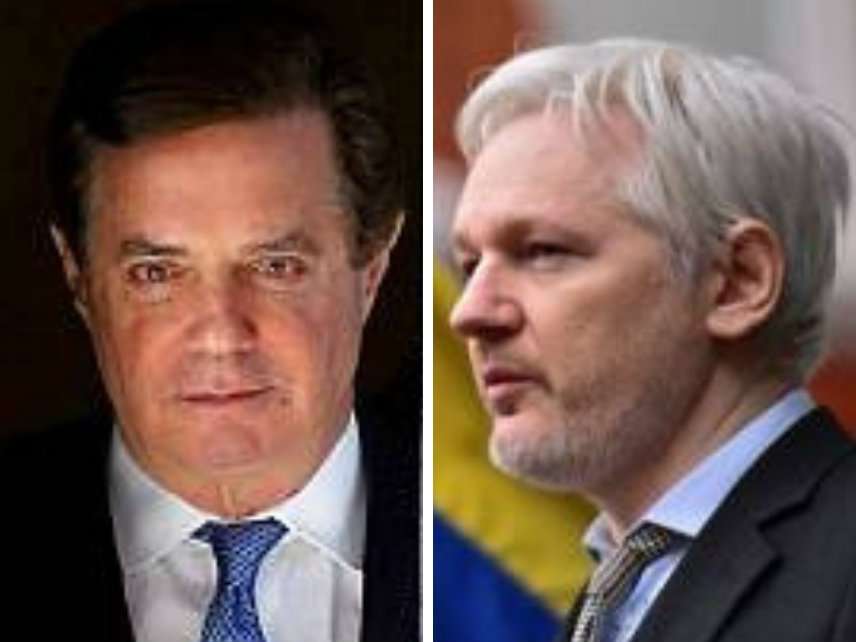Report Claims Paul Manafort Met With Julian Assange Months Before WikiLeaks Published DNC Emails
But WikiLeaks and Manafort have pushed back on the report.

Former Trump campaign chairman Paul Manafort met with WikiLeaks founder Julian Assange multiple times between 2013 and 2016, according to The Guardian. One of those meetings reportedly occurred in spring 2016, around the time Manafort joined the Trump campaign and several months before WikiLeaks published Democratic National Committee (DNC) emails that were obtained by Russian hackers.
Citing a "well-placed source," the Guardian says Manafort went to see Assange at the Ecuadorian embassy in London around March 2016, though the exact date is "tentative." It was several months later, on July 22, that WikiLeaks published thousands of DNC documents obtained by Russia's Main Intelligence Directorate of the General Staff, or GRU. Nearly two years later, in July 2018, Deputy Attorney General Rod Rosenstein announced the Department of Justice (DOJ) had filed criminal charges against 12 Russian intelligence officials who were allegedly involved in the hack.
As the Guardian notes, Manafort has claimed he had nothing to do with the hack. It's also not clear what Manafort and Assange spoke about. But an internal document authored by Secretaría Nacional de Inteligencia (SENAIN), Ecuador's intelligence agency, suggests that when Manafort visited Assange in 2013, he was joined by "Russians."
He came back at least two more times. Per the Guardian:
According to two sources, Manafort returned to the embassy in 2015. He paid another visit in spring 2016, turning up alone, around the time Trump named him as his convention manager. The visit is tentatively dated to March.
WikiLeaks, meanwhile, quickly denied the Guardian's report, indicating Manafort never met with Assange.
Remember this day when the Guardian permitted a serial fabricator to totally destroy the paper's reputation. @WikiLeaks is willing to bet the Guardian a million dollars and its editor's head that Manafort never met Assange. https://t.co/R2Qn6rLQjn
— WikiLeaks (@wikileaks) November 27, 2018
Manafort was officially named Trump's convention manager on March 29, 2016. On May 19, he was promoted to campaign chairman and chief strategist. But things went downhill for him from there. The New York Times reported in August that Manafort had received undisclosed payments from former Ukrainian President Viktor F. Yanukovych's political party. Manafort denied it:
this was easily the best Manafort moment from the campaign pic.twitter.com/Va63SLdb4o
— Joe Perticone (@JoePerticone) November 27, 2018
Manafort left the Trump campaign later that month. More than a year later, in October 2017, he became the first person to be indicted by Special Counsel Robert Mueller as part of a larger investigation of Russian meddling in the 2016 presidential election. As Reason's Scott Shackford reported this past August, Manafort was found guilty of eight out of 18 charges related to tax evasion and bank fraud.
Manafort later accepted a plea deal in Mueller's Russia probe. But that deal now appears to be falling apart, as Mueller has accused Manafort of lying to both the FBI and Mueller's office.
Trump, meanwhile, has continued to deny that his campaign colluded with Russia:
The Phony Witch Hunt continues, but Mueller and his gang of Angry Dems are only looking at one side, not the other. Wait until it comes out how horribly & viciously they are treating people, ruining lives for them refusing to lie. Mueller is a conflicted prosecutor gone rogue….
— Donald J. Trump (@realDonaldTrump) November 27, 2018
….The Fake News Media builds Bob Mueller up as a Saint, when in actuality he is the exact opposite. He is doing TREMENDOUS damage to our Criminal Justice System, where he is only looking at one side and not the other. Heroes will come of this, and it won't be Mueller and his…
— Donald J. Trump (@realDonaldTrump) November 27, 2018
….terrible Gang of Angry Democrats. Look at their past, and look where they come from. The now $30,000,000 Witch Hunt continues and they've got nothing but ruined lives. Where is the Server? Let these terrible people go back to the Clinton Foundation and "Justice" Department!
— Donald J. Trump (@realDonaldTrump) November 27, 2018
UPDATE: Following publication of this article, WikiLeaks said it plans to sue The Guardian over what it claims is an inaccurate report. Manafort has also responded, calling the report "totally false and deliberately libelous."
Some in the media world, meanwhile, have raised questions over the Guardian's report, noting that the sourcing is vague and that if Manafort really did visit Assange at the Ecuadorian embassy in London, there would be more evidence, including video proof. Moreover, Luke Harding, who wrote the report, is the author of a book titled "Collusion: How Russia Helped Trump Win the White House."




Show Comments (337)